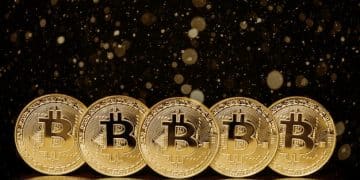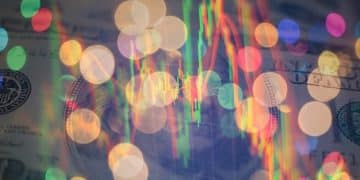Federal Reserve Policy Impact on US Growth in 2025: An Analysis
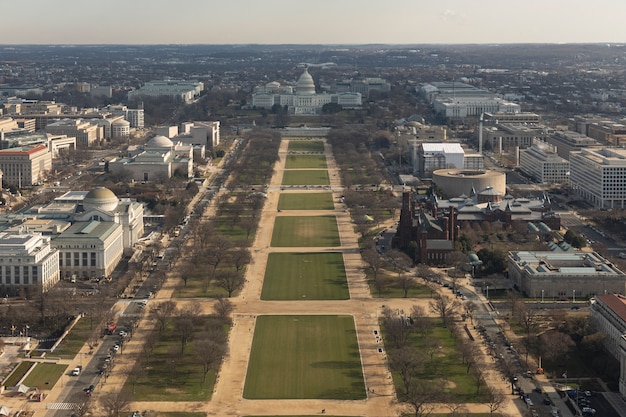
Understanding the Impact of the Federal Reserve’s Monetary Policy on US Economic Growth in 2025 involves analyzing interest rate adjustments, inflation targets, and quantitative easing strategies to predict their effects on GDP, employment, and investment within the US economy.
The question of Understanding the Impact of the Federal Reserve’s Monetary Policy on US Economic Growth in 2025 is a critical one for investors, policymakers, and everyday citizens alike. What levers does the Fed control, and how might their decisions influence our economic future?
The Federal Reserve’s Role in Economic Growth
The Federal Reserve, often called the Fed, plays a crucial role in steering the US economy. Through its monetary policy, the Fed influences interest rates and credit conditions, which, in turn, affect employment, inflation, and economic growth.
Monetary Policy Tools
The Fed uses several tools to implement its monetary policy, each with its own set of impacts. These tools primarily influence the money supply and credit availability.
- Federal Funds Rate: The target rate that banks charge each other for the overnight lending of reserves.
- Discount Rate: The interest rate at which commercial banks can borrow money directly from the Fed.
- Reserve Requirements: The fraction of a bank’s deposits that they are required to keep in their account at the Fed or as vault cash.
- Open Market Operations: The buying and selling of government securities in the open market to influence the level of bank reserves.
These tools are interconnected and are used in concert to achieve the Fed’s dual mandate of price stability and maximum employment. Adjustments to these tools can have immediate and lasting effects on the economy.
In summary, the Federal Reserve’s monetary policy tools are critical instruments that shape the economic landscape by influencing interest rates, credit availability, and overall financial conditions. Understanding these tools is essential to grasping how the Fed aims to achieve its dual mandate of price stability and maximum employment, ultimately impacting economic growth.
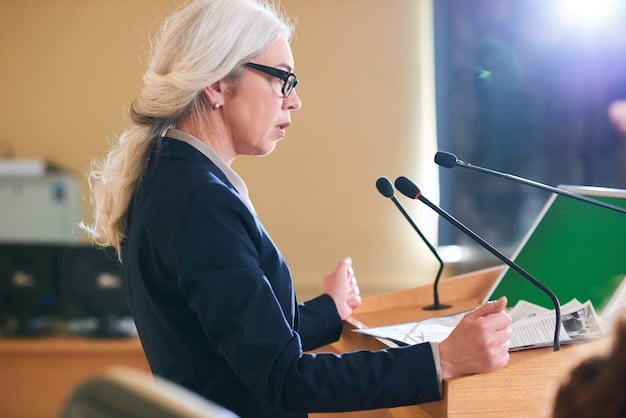
Interest Rate Adjustments and Their Effects
Interest rate adjustments are a primary tool the Fed uses to manage economic growth. By raising or lowering interest rates, the Fed influences borrowing costs for businesses and consumers.
Impact on Borrowing and Investment
When the Fed raises interest rates, borrowing becomes more expensive. This can lead to reduced spending and investment, as businesses and consumers are less likely to take out loans. Conversely, when the Fed lowers interest rates, borrowing becomes cheaper, encouraging spending and investment.
Effects on Inflation
Interest rate adjustments also play a role in managing inflation. Higher interest rates can help to curb inflation by reducing demand in the economy. Lower interest rates can stimulate demand, potentially leading to higher inflation.
The effects of interest rate adjustments can be complex and may take time to materialize. Nonetheless, they are a powerful tool for influencing economic growth.
In closing, interest rate adjustments are a cornerstone of the Federal Reserve’s monetary policy strategy, wielding significant influence over borrowing costs, investment decisions, and inflation dynamics. These adjustments ultimately play a pivotal role in shaping economic growth trajectories within the US.
Inflation Targets and Economic Stability
The Federal Reserve aims to maintain price stability by setting inflation targets. These targets provide a benchmark for monetary policy decisions and help manage expectations.
The 2% Inflation Target
The Fed has an explicit inflation target of 2% per year. This target is considered consistent with price stability and allows for a buffer against deflationary pressures. Deflation can be particularly harmful to an economy.
How Inflation Targets Guide Policy
Inflation targets guide the Fed’s decisions on interest rates and other monetary policy tools. If inflation is above the target, the Fed may raise interest rates to cool down the economy. If inflation is below the target, the Fed may lower interest rates to stimulate demand.
Ultimately, inflation targets are essential for maintaining economic stability. By managing expectations, the Fed can help to minimize uncertainty and support sustainable growth.
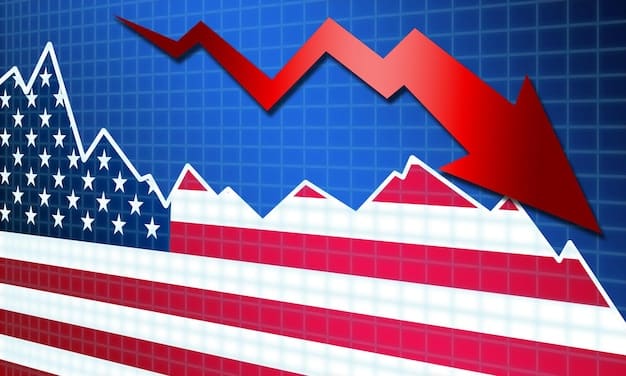
Quantitative Easing and Its Implications
Quantitative easing (QE) is a monetary policy tool used by central banks to increase the money supply and stimulate economic activity. It typically involves the central bank buying government bonds or other financial assets.
How QE Works
QE works by injecting liquidity into the financial system. This can lower long-term interest rates, encourage lending, and boost asset prices. The goal is to stimulate demand and promote economic growth.
Potential Risks of QE
While QE can be effective in certain circumstances, it also carries potential risks. One concern is that it could lead to higher inflation. Another is that it could distort asset prices and create bubbles.
- Inflationary Pressures: Increased money supply can lead to higher prices.
- Asset Bubbles: Inflated asset prices can destabilize markets.
- Currency Devaluation: QE can weaken the national currency.
As such, QE is a tool that must be used judiciously. The Fed must weigh the potential benefits against the potential risks.
To conclude, quantitative easing (QE) presents a dual-edged sword, capable of injecting vital liquidity into the financial system and stimulating economic activity while simultaneously posing risks such as inflationary pressures and asset bubbles. The Federal Reserve must carefully evaluate the potential benefits and drawbacks when considering the implementation of QE as a monetary policy tool.
Forecasting US Economic Growth in 2025
Forecasting economic growth is a complex task that involves analyzing a wide range of factors. These factors include government policies, global economic conditions, and technological developments.
Key Economic Indicators
Several key economic indicators can provide insights into the outlook for US economic growth in 2025. These indicators include:
Examining these indicators can provide valuable context for understanding potential economic trajectories and challenges.
- GDP Growth Rate: The percentage change in the gross domestic product.
- Unemployment Rate: The percentage of the labor force that is unemployed.
- Inflation Rate: The percentage change in the consumer price index.
- Consumer Confidence Index: A measure of consumer sentiment about the economy.
By monitoring these indicators, policymakers and investors can gain a better understanding of the state of the US economy and make more informed decisions.
In summary, forecasting US economic growth in 2025 requires a comprehensive analysis of several key economic indicators, including GDP growth rate, unemployment rate, inflation rate, and consumer confidence index. Monitoring these indicators enables policymakers and investors to better understand the state of the US economy, empowering them to make more informed decisions.
Potential Challenges and Risks
Several potential challenges and risks could impact US economic growth in 2025. These include geopolitical tensions, trade disputes, and technological disruptions.
Geopolitical Risks
Geopolitical tensions can disrupt global supply chains, increase uncertainty, and dampen economic activity. Events such as wars, political instability, and terrorism can all have negative impacts on the economy.
Trade Disputes
Trade disputes can lead to higher tariffs, reduced trade flows, and increased uncertainty. These can harm businesses and consumers, leading to slower economic growth.
Technological Disruptions
Technological disruptions can create both opportunities and challenges. While new technologies can boost productivity and innovation, they can also lead to job losses and increased inequality.
In closing, a series of potential challenges and risks, including geopolitical tensions, trade disputes, and technological disruptions, could significantly impact US economic growth in 2025. These factors necessitate careful monitoring and strategic planning to mitigate their potential adverse effects on the economy.
| Key Point | Brief Description |
|---|---|
| 🔑 Fed’s Role | Influences rates, credit, and manages unemployment & inflation. |
| 🎯 Inflation Target | Aims for 2% annually to maintain economic stability. |
| 💵 Quantitative Easing | Injects money to stimulate but risks inflation & asset bubbles. |
| 📈 Key Indicators | GDP growth, unemployment, inflation, consumer confidence. |
Frequently Asked Questions
▼
The Federal Reserve aims to promote maximum employment and price stability in the US economy, often referred to as its dual mandate. Economic growth supports this mandate.
▼
Raising rates can slow spending and inflation, while lowering rates can encourage borrowing and investment. These changes influence economic activity.
▼
QE is when the Fed buys government bonds or other assets to increase the money supply, lower rates, and stimulate economic growth during downturns.
▼
The 2% target is considered consistent with price stability and provides a buffer against deflation, helping maintain economic predictability and stability.
▼
The Fed watches GDP growth, unemployment, inflation, and consumer confidence to assess the economy’s health and inform monetary policy decisions.
Conclusion
Understanding the Impact of the Federal Reserve’s Monetary Policy on US Economic Growth in 2025 requires careful consideration of various factors, including interest rates, inflation targets, and external challenges. By monitoring these elements, policymakers and investors can better navigate the economic landscape and make informed decisions.
